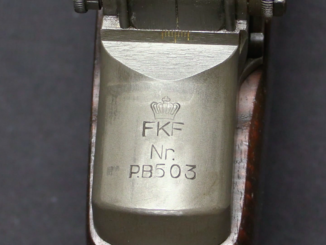This is no ordinary firearms reference book. This is a 900-page, nearly 12 pound tome in Italian. And not justify Italian; hand-written cursive Italian. With a substantial number of hand-painted illustrations. It is about the history of the Terni Arsenal and its products, from the needlefire Carcano through the M91 in World War Two. I can’t read Italian, but the sections at the end covering a number of unusual experimental weapon designs persuaded me to order a copy, and I don’t regret it (although it is an expensive book, at about $150 shipped depending on where you buy it). I really can’t offer any review of the text content as a result, but if the depth and scale of the information matches that of the illustrations, it must be quite substantial. Definitely not a book for everyone – or even for very many – but it’s quite the impressive work to look at!
Related Articles

Submachine Guns
Bernardelli VB: Not Actually a Beretta 38 Copy
This is Lot 1069 in the upcoming October 2019 Morphys Extraordinary auction. The Bernardelli company, known mostly for sporting arms, made an effort to break into the law enforcement/military/security market in the year after World […]

Semiauto Rifles
Danish Gevaer m/50 – An American Gun Made in Italy
Dozens of countries around the world received M1 Garand rifles from the United States in the decades after World War Two, and Denmark was one of those that not only got some rifle but went […]

Semiauto pistol
M1942 Sosso Pistol
The Sosso was an interesting design produced experimentally by FNA Bescia in Italy in very small numbers during World War II. It was a short-recoil operated design chambered for 9x19mm, and featured a particularly unusual […]

In response to your smart phone comment. Google translate. https://translate.google.com and then think about a book scanner, see PC Mag review, https://www.pcmag.com/review/358946/czur-et16-plus. The files would then be searchable using whatever works for you. I am a Mac guy so I use Spotlight to look for PDF text strings. Not of course for this book but at this rate you will be adding rooms onto your house to store your collection. 🙂 Time to think about electronic storage and search.
“(…)hand-written(…)”
This seems to be another hint, that Italians very highly prize style, or at least more than readability. I guess this using OCR at this book would give poor results.
As a European you know that Italian undertakings were always about style and beauty. This makes them unique and irreplaceable.
I really hope I’m not being useless here, as one person suggested yesterday (and if you guys really want me to permanently quit, just say so explicitly).
If optical-character-reading doesn’t work, then how should you interpret the letters apart from looking up cursive alphabets in your computer’s word-processing character map or doing a search on cursive alphabets online? I don’t know about European or Canadian schools, but lots of American schools stopped teaching cursive writing at some point within the past twenty years. Personally, I think that was a mistake. I was informed by one of the local librarians that she watches grade-schoolers writing really sloppy print on weekends, and that after the schools stopped teaching cursive, the sloppy writing got WORSE. The interpretation: learning cursive script forces the writer to slow down and make sure he can READ his own handwriting.
“(…)lots of American schools stopped teaching cursive writing at some point within the past twenty years.(…)”
According to https://en.wikipedia.org/wiki/Cursive#Conservation_efforts_and_cognitive_benefits some states mandated cursive in schools.
“(…)If optical-character-reading doesn’t work(…)”
Then if you really need electronic text version you need to hire someone who known Italian AND is able to decipher peculiar font.
“(…)slow down(…)”
Well, so place of that “cursive” is positively in museum display – think as you wish, but fact is that “faster” fonts displace “slower” fonts.
I meant to say in the last issue that you’ve got to be able to read anything you write. Writing cursive taught me to write more neatly, something that also is relevant to my work, even though I do my work in print!
Hey Daweo…. just occurred to me. Do you have knowledge of old German (gothic) cursive writing? https://en.wikipedia.org/wiki/Schwabacher
My parents, in inter-bellum period at high school, had it as mandatory subject. It is exceedingly pretty and carries with it Teutonic mystique. When I stared to learn German language, I encountered Latin letters only. I’d have real difficulty to read text it Schwabach.
“My parents, in inter-bellum period at high school, had it as mandatory subject.”
Then it probably was Faktur for decoding it, you might use Germanic Alphabet Chart available there: https://www.familytreemagazine.com/premium/7-websites-for-deciphering-old-german-script/
This font was widely used in German pre-WWII, for example take look at this Kriegstagebuch from 1917:
http://tsamo.germandocsinrussia.org/ru/nodes/36-delo-26-zhurnal-boevyh-deystviy-216-rezervnogo-pehotnogo-polka#page/2/mode/inspect/zoom/4
(scroll down after opening, use looking glass with + to zoom in and looking glass with – to zoom out)
I am able to (slowly) read text in said Fraktur, though honestly using knowledge of Deutsch to guess next word rather than read, but NO way able to read Kurrentschrift or even (supposedly simpler) Sütterlinschrift.
Anyway, as side note it is worth noting that even, Fraktur was officially banned, Germans start using DIN1451Schrift whereas unobstructed reading was important, for example traffic signs (including roads names) and technical documentation.
is: “(…)even, Fraktur(…)”
should be: “(…)even before Fraktur(…)”
“Writing cursive taught me to write more neatly, something that also is relevant to my work, even though I do my work in print!”
Well, it aligns with my not expressed yet observation: cursive is Bristol Brabazon of hand-writing, fitting to bygone era [of piston propelled luxury airliners] unable to compete with other design of same year but following another design philosophy. Independently from lack of economic success, its development surely gives some experience.
“Cursive writing”… a big subject, after you touched on it. I would not even dare to come up with it, but if you did, I back you up 100%. Absolutely, kids are not taught how to write; we are becoming factually illiterate. And this is presumably in area of apex of human civilization!
Yes, back in Central Europe in 1950s, we were led to “pretty writing”. Did it make sense? I leave it to others to judge. At least it thought kids discipline. In Canada, this art has slowly vanished (and in old continent likely the same) and now, including myself we cannot do better than “print”. It may be worth of looking at the subject again – not necessarily as an obligatory part of curriculum, but still, it should receive attention of educators.
Your own contributions are a spice to this page’s taste – please keep writing!
As I forgot to mention it…. cursive writing carries with it sort of ‘intimacy’, at last in my way of looking at it. Regular printed text is ‘inert’ – no personal feelings of writer are attached. At least not explicitly.
“not necessarily as an obligatory part of curriculum, but still, it should receive attention of educators.”
What I could say there? It is clear than hand dexterity can be enhanced by proper training, but for me it is disputable if it should be writing text using fancy fonts or something another.
Also with our discussion we touch topic of FORM vs FUNCTION which remain actively disputed by architects from very,very,very long time ago, as shown here: https://www.bluefountainmedia.com/blog/form-function-website-design
A point of interest for Daweo:
as you may know, the true “second” language for me was Russian. And same as with my mother tongue, we were taught to use handwrite script. After a while it becomes natural. Actually, Russian text in this for looks quite pretty to me. You ask me to do it today 🙂
You are not telling me that no one has come up with a scanner app that cannot translate pages from a book. Surely that has been done.
You need to have the text transcribed into regular print BEFORE you can translate it. I’m not sure most programs can read handwritten cursive, but you are right, there are scan-and-translate apps out there. We just need a program that can interpret handwritten cursive from a scan, transcribe it (with a function to allow human intervention if something’s been transcribed wrong), and then translate it.
I have a friend who does book translation from English to Italian
They’re not cheap, and this book looks more like a labour of love than a commercial venture. That said, Italy does still have really good bookshops even in surprisingly small villages, worthwhile books still sell there.
I was going to try to steer well clear of the subject of schools teaching illiteracy
I guess that I’ll dip my toe in;
The politically incorrect, try to explain low literacy in some parts of America by reference to “the bell curve”
Yet, Jamaican blacks have a higher literacy rate than American whites…
If the bell curve were real, what would that say about the quality (and value for money) of American schooling?
” Jamaican blacks have a higher literacy rate than American whites…”
Does both figures refer to English language?
Very dubious statement, considering that the adult literacy rate in Jamaica is around 80%.
Especially since only 75% of Jamaicans get more than 6 years of school, compared to the 90% of Americans who finish all 12 years of high school.
Yup
Oh hell yes, Caribbean blacksmith are typically a lot better educaated than American, British or Australian whites. The same can probably be said for Nigerian, Ghanaian and Kenyan blacks, even (or perhaps especially) in the slums!
Outside of the English speaking world, I attended the one of my Italian Nieces’ school vivas. She was 14 years old at the time.
It included a good cross section of the philosophies of science, including logical positivism and Popperian falsificationism.
Unless you are doing philosophy or sociology at Batchelors or masters level, you absolutely don’t get to meet that in the English speaking world.
I encountered Thomas Kuhn’s “structures” at about age 21. I didn’t read it from cover to cover until we were both well over 50. My Italian neices were there and understood it at 14!